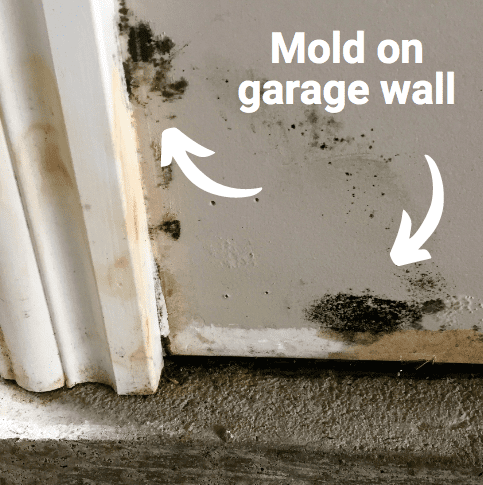Garage Mold Removal
Mold growth is a common problem that can affect various areas of our homes, including garages. Although often overlooked, garages are susceptible to mold infestations due to their damp and humid conditions. In this blog, we will explore why mold can develop in your garage, the potential damage it can cause, effective removal methods, and preventive measures to keep your garage mold-free.
Why is there Mold in Your Garage?
Moisture and Humidity: Garages typically have poor ventilation and may accumulate moisture from various sources, such as leaky roofs, foundation cracks, or improper drainage. This excess moisture combined with limited airflow creates an ideal environment for mold growth.
Water Intrusion: If your garage has experienced water leaks, flooding, or high humidity levels, it can create the perfect breeding ground for mold spores. Moisture can seep through walls, windows, or door seals, promoting mold growth on surfaces and in hidden areas.
Lack of Maintenance: Neglected garages with poor maintenance practices, such as inadequate cleaning, lack of insulation, or improper storage of wet items, can contribute to mold growth. Regular maintenance is crucial to preventing mold in your garage.
What Kind of Damage Can Mold Do in My Garage?
Structural Damage: Mold can gradually deteriorate the integrity of your garage’s structure, compromising the strength of wooden beams, drywall, and other materials. This can lead to costly repairs or even the need for extensive renovations.
Health Risks: Mold spores can cause health issues, especially for individuals with respiratory conditions or weakened immune systems. Exposure to mold in your garage can result in allergic reactions, respiratory problems, and other related symptoms.
Odor and Aesthetics: Mold growth in garages often leads to unpleasant musty odors that can permeate into the living spaces of your home. Additionally, visible mold patches can stain walls, ceilings, and stored items, detracting from the overall appearance of your garage.
How Should Garage Mold be Removed?
Safety First: Before attempting any mold removal, ensure you have the appropriate protective gear, such as gloves, goggles, and a respirator mask. If the mold covers a large area (over 10 square feet), it is best to consult professional mold removal experts.
Containment: To prevent the spread of mold spores, isolate the affected area by sealing off the garage from the rest of the house. Close doors leading into the house and cover vents with plastic sheeting.
Cleaning and Disinfecting: Use a mixture of water and mild detergent to scrub mold-infested surfaces thoroughly. For non-porous materials, you can use a solution of bleach and water (1:10 ratio) to disinfect. Dry the area completely afterward to discourage further mold growth.
Proper Ventilation: Improve airflow in your garage by opening windows, using fans, or installing vents. This helps in drying out the space and reducing humidity levels.
How Can I Prevent Garage Mold in the Future?
Moisture Control: Address any water leaks, fix roof or plumbing issues promptly, and ensure proper drainage around the garage. Consider installing a dehumidifier to maintain optimal humidity levels.
Good Ventilation: Install vents or exhaust fans to facilitate air circulation within your garage. Open windows and doors periodically to allow fresh air in.
Regular Cleaning: Keep your garage clean and free from clutter. Regularly sweep or vacuum to remove dust and debris that can contribute to mold growth. Pay attention to corners, walls, and any potential moisture-trapping areas.
Proper Storage: Store items in your garage in a way that promotes airflow and prevents moisture buildup. Avoid storing wet or damp items, as they can become a breeding ground for mold.
Protecting your garage from mold is essential for maintaining a safe and healthy environment. By understanding the causes of garage mold, taking preventive measures, and promptly addressing any signs of mold growth, you can ensure a mold-free garage in Minneapolis, MN. If you’re dealing with a significant mold problem or need professional assistance, don’t hesitate to reach out to Certified Mold Removal, your trusted expert in mold remediation.
Can mold grow in a concrete garage?
Yes, mold can grow in a concrete garage if there are moisture issues or high humidity levels present.
What kills mold spores on concrete?
To kill mold spores on concrete, you can use a solution of water and bleach (1:10 ratio). Apply the solution to the affected area and let it sit for 15 minutes before scrubbing and rinsing thoroughly.
Why does mold keep coming back on concrete?
Mold can keep coming back on concrete if the underlying moisture issue is not properly addressed. If the moisture source is not eliminated, the conditions will remain favorable for mold growth.
How long does it take for concrete to get out of the mold?
The time it takes for concrete to fully dry out after mold remediation depends on various factors, such as the extent of moisture exposure, ventilation, and humidity levels. It typically takes several days to weeks for concrete to completely dry.
Can mold travel through concrete walls?
Mold spores are microscopic and can travel through porous materials, including concrete walls, if the conditions are favorable. However, it’s important to note that mold growth typically occurs on the surface of concrete rather than inside the material itself.
What is the best concrete sealer to prevent mold?
Using a high-quality moisture-resistant concrete sealer is recommended to help prevent mold growth on concrete surfaces. Epoxy-based sealers or those specifically designed for mold prevention can be effective options.
How do I know if my garage has mold?
Signs of mold in a garage can include a musty odor, visible mold growth on surfaces, discoloration or staining on walls or ceilings, and allergic reactions or respiratory symptoms experienced by individuals spending time in the garage.
Can mold seep through concrete?
Mold itself does not seep through concrete, but mold spores can settle on the surface of concrete and grow if moisture and other favorable conditions are present. Proper moisture control is key to preventing mold growth on concrete surfaces.
 Call: (612)-367-7767
Call: (612)-367-7767

